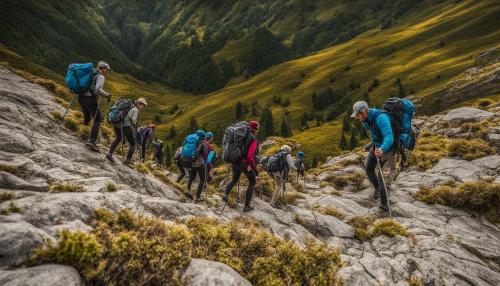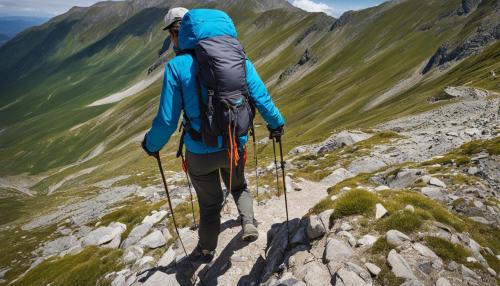Whether you’re a seasoned mountaineer, a devoted trail runner, or an outdoor enthusiast embarking on rugged expeditions, understanding the professional uses of trekking and hiking poles can transform your outdoor experiences. In the realm of outdoor gear, these poles have become hiking essentials, renowned for their trekking pole benefits that go far beyond mere walking support. In this expert guide, we delve into the sophisticated world of professional hiking equipment, spotlighting the multifaceted walking stick uses that aid in stability, safety, and efficiency. From their role in load distribution to their contribution to injury prevention, trekking poles are more than accessories; they’re vital tools for the professional outdoors.
Key Takeaways
- Grasp the significance of trekking poles as essential outdoor gear for professional use.
- Discover the vast array of trekking pole benefits in performance enhancement and injury prevention.
- Learn how walking stick versatility extends to support in various professional hiking equipment scenarios.
- Understand the role of trekking poles in maintaining stability and safety on diverse terrain types.
- Gain insights into the specialized techniques for optimal walking stick use in professional settings.
- Acknowledge the importance of quality construction materials, such as carbon fiber and aluminum, in trekking poles.
Understanding the Essentials: What Are Trekking Poles?
When embarking on an outdoor adventure, having the right gear is crucial for both safety and performance. Trekking poles are an integral part of this equipment lineup, offering stability and support on a wide variety of terrains. In this section, we dive into the anatomy of these essential tools, explore the distinctive features of various types, and discuss the materials that make them both durable and lightweight.
The Anatomy of a Trekking Pole
Trekking poles may appear straightforward, but they consist of several key trekking pole components that enhance their functionality. From the tip, which provides traction, to the grip, which ensures comfort and control, each part plays a vital role in a pole’s performance.
Types of Trekking Poles and Their Unique Features
The variety of trekking poles available caters to the needs of every outdoor enthusiast. Some prefer adjustable poles for their versatility, while others opt for shock-absorbing poles to reduce the impact on joints during long descents. Let’s compare the key features to help you find your perfect match.TypeMain FeatureBest UseAdjustable PolesTelescopic length adjustmentAdaptable for various heights and terrainsShock-absorbing PolesInternal springs absorb impactDownhill treks, reducing knee stressFoldable PolesCollapsible for easy storageTravelers with limited packing space
Materials Used in Pole Construction
The choice between carbon fiber and aluminum is not just a matter of preference; it affects the weight, durability, and flexibility of the hiking poles. Carbon fiber is known for being exceptionally lightweight, while aluminum offers unmatched toughness, often at a more affordable price point.
Professional Uses of Trekking Poles, Walking Sticks and Hiking Poles
Trail running often involves unpredictable paths where the enhanced balance provided by trekking poles can be the difference between a steady ascent and a potential fall.
According to Trail Runner Magazine, the strategic use of poles in trail running can conserve energy during long climbs and provide additional stability during rapid descents.
Mountaineering adventures call for precise movement and a high degree of safety, where trekking poles act as an extended point of contact with the ground. They assist in distributing weight more evenly, allowing for confident steps even when the path is obscured by snow or foliage.
When it comes to backcountry skiing, poles become critical for balance and maneuvering through deep powder or crude terrain. The ability to probe the snow ahead for hidden crevasses or inconsistencies in the snowpack is a safety feature that cannot be overstated.
Expedition guides rely on these tools to not only aid their traversal but also to model proper technique and safety protocols for their clients. As noted by International Mountain Guides, trekking poles have become an essential piece of equipment for leading successful expeditions.
- Grip enhancement on slick or unstable surfaces
- Reduction of impact on knees and legs during long descents
- Energy conservation by involving upper body in ascents
- Improved balance and rhythm which enhance overall pace
The testimony of seasoned outdoor professionals underscores the transformative impact of trekking poles. Their usage is a cornerstone of expert technique, demonstrating that the right gear is paramount to thriving in the natural playgrounds of Mother Nature’s design.
Maximizing Efficiency: Techniques for Proper Pole Usage
Mastering the use of trekking poles is vital for hikers and outdoor professionals looking to improve their walking rhythm and efficiency on the trail. Understanding the intricacies of pole adjustment techniques, obtaining an ergonomic grip, and accurately adapting to varying terrains can substantially enhance one’s hiking experience. Let’s delve into how to fine-tune these elements for peak performance.
Adjusting Your Poles to the Correct Height
Adjusting your trekking poles to the right height is crucial for maintaining proper posture and reducing strain. The elbow should form a 90-degree angle when the pole’s tip touches the ground. Adapting your pole length as you transition between uphill and downhill paths helps in conserving energy and supporting your joints during your journey.
Grip Methods for Various Terrains
An ergonomic grip on your trekking poles keeps your hands comfortable and enhances your control over various terrain types. In rocky or uneven environments, loosening your grip can help absorb shock more effectively. Conversely, in stable conditions, a firmer grip provides better support.
Stride and Pole Coordination for Optimal Support
Coordinating your stride and pole use is essential for establishing a steady walking rhythm. Syncing your pole plant with the opposite foot’s stride offers a balanced walking technique, improving efficiency and reducing fatigue. Terrain adaptation becomes smoother when you develop this rhythmic pattern, adjusting your steps to suit the landscape.
Advanced Skills: Navigating Difficult Terrain With Poles
Confronting technical terrain often intimidates even the most seasoned hikers, but with advanced hiking techniques, individuals can transform daunting landscapes into navigable adventures. The strategic use of trekking poles across tough trail conditions not only provides necessary support but also implicates refined professional trekking skills. During ascents on steep slopes or traverses through irregular rocky pathways, trekking poles become an extension of one’s limbs, crafting a four-point stability system that reduces the impact on knees and aids in maintaining balance.
When facing slippery surfaces—whether they be wet rocks or icy patches—trekking poles enhance safety by providing additional points of contact with the ground. Here, hikers must utilize poles to probe for hidden obstacles, test the stability of what lies ahead, and redistribute weight effectively. Grasping these techniques transforms the unpredictable outcomes of complex terrains into a series of strategic movements. Mastering pole placement and weight distribution can conserve vital energy throughout the duration of rigorous expeditions.Terrain TypePole AdjustmentTechniqueBenefitsSteep InclineShorten LengthDouble PlantingImproved Uphill LeverageRough RocksMedium LengthSingle PlantingIncreased StabilityMuddy PathMedium LengthAlternate PlantingPrevents SinkingSlippery SurfacesLonger LengthTesting GroundEarly Hazard Detection
“Trekking poles as tools, not just accessories”
Venturing across a mosaic of treacherous grounds calls for a unique blend of professional trekking skills that are honed over time. Utilizing, “Trekking poles as tools, not just accessories” as suggested by experts in National Geographic, could be the defining factor that ensures the hiker’s triumph over technical terrain. The difference between a laborious plight and an exhilarating conquest could lie in the proficient employment of these trusted poles.
- Double Planting: Both poles are planted together to give an extra push.
- Single Planting: Alternating the pole with each step for rhythm.
- Alternate Planting: Using poles independently to navigate tricky footing.
- Testing Ground: Using poles to test the firmness of questionable surfaces.
The insights offered by esteemed sources such as Outside Magazine and Adventure Alan emphasize that the essence of conquering formidable trails blends mental acuity with physical prowess, all encapsulated in the technique of pole usage. Whether aiming for efficiency or navigating an arduous journey, the refined skills of trekking pole employment are vital for today's outdoor professionals facing complex tough trail conditions.
Enhancing Performance: Conditioning and Training With Poles
Embracing the versatility of trekking poles, professionals are incorporating these tools into their fitness routines for enhanced conditioning. Beyond mere hiking companions, poles have emerged as multifaceted instruments for injury prevention and rehabilitation. Let’s delve into how integrating fitness training with poles can amplify your training regimen and lead to significant performance strides.
Incorporating Poles into Your Training Regimen
Regular incorporation of trekking poles into exercise routines has proven to bolster core strength and augment the workout intensity. Many fitness enthusiasts have noted the poles’ ability to transform basic movements into full-body workouts, effectively enhancing cardiovascular exercise and muscle endurance. This addition to training not only elevates physical conditioning but can also help in mimicking challenging outdoor terrains indoors or on flat surfaces.
The Role of Poles in Injury Prevention and Rehabilitation
Injury prevention is a crucial aspect of any training, and trekking poles offer an added layer of protection for joints and muscles. Their use can decrease impact on knees during descents and provide stability on uneven surfaces, mitigating the risks of falls and strains. Similarly, rehabilitation exercises with poles aid in slowly building up the strength and mobility of individuals recovering from injuries, thus ensuring a safer and more controlled recovery process.
Measuring Performance Improvements With the Use of Poles
Tracking progress holds paramount importance in any fitness agenda. By implementing poles in a range of activities, individuals can monitor enhancements in stamina, strength, and agility. Experts recommend keeping a detailed log of exercises, both with and without poles, to observe measurable differences in performance metrics. From increased speeds on trails to extended distance capabilities, the role of poles in advancing athletic performance is significant and quantifiable.
American Council on Exercise emphasizes the utility of poles, stating, “Trekking poles not only enhance your stability and provide support, but they also promote upper body and core conditioning, turning a simple walk into a full-body workout.”
The Future of Trekking and Hiking Poles in Outdoor Professions
As we look to the horizon of outdoor exploration, innovative pole technology stands at the forefront, promising to vastly improve the trekking experience for outdoor professionals. These advancements are not just about minor improvements, but a revolution in the ergonomic design trends and capabilities of hiking poles. GearPatrol highlights how the integration of cutting-edge materials and smart design is setting the stage for the next great leap in professional trekking equipment.
Outside Magazine delves into the burgeoning future outdoor equipment landscape, forecasting that the new wave of professional trekking advancements will hinge largely on user-centric design. This focus on ergonomics is expected to significantly reduce fatigue and enhance performance. By adopting more responsive and lighter materials, coupled with adjustable and more intuitive features, future trekking and hiking poles will cater to a wide range of environmental challenges and personal preferences.
Ultimately, the enduring goal within this evolving market is to provide outdoor professionals with tools that are not merely functional but are extensions of their will to navigate and conquer the natural world. Tomorrow’s trekking poles will bring increased efficiency and safety to the trail, reinforcing the importance of reliable gear in professional pursuits. As technology continues to permeate outdoor gear, the professionals who wield these advanced trekking poles will embark with a renewed confidence, ready to face whatever path lies ahead.
















